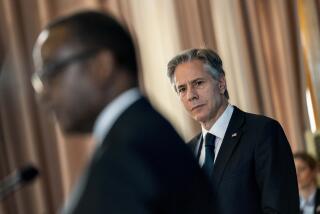Video on Ugandan militia leader Joseph Kony sparks an uproar
- Share via
Even after decades of well-documented murder and plunder, even after the International Criminal Court indicted him and a U.S. president dispatched a special forces team to help catch him, African warlord Joseph Kony remained largely obscure to the West.
That changed with startling swiftness this week, with the viral proliferation of a smoothly produced 29-minute video, “Kony 2012,” that calculatedly taps the power of social media in an effort to make the fugitive leader of the Lord’s Resistance Army a figure of global infamy.
By Thursday, three days after its release on YouTube, the video had been viewed 40 million times, fueled by Tweets from celebrities including Rihanna, Oprah Winfrey and P. Diddy.
VIDEO: Kony 2012 targets Uganda militia leader
Photos: The cruelty of Kony’s army
“Can I tell you the bad guy’s name?” Jason Russell, co-founder of the San Diego-based non-profit Invisible Children, asks his young son in the video. Russell then shows him Kony’s photograph, and explains to viewers that the LRA abducts children like him for use as sex slaves and child soldiers. Then he inveighs against the possible withdrawal of U.S. troops sent by President Obama last year to help African troops catch Kony.
The video marks the latest example of how social media have transformed political activism — a phenomenon seen in events including President Obama’s election and the “Arab Spring” uprisings. The video’s popularity reflects the power of Facebook and Twitter to galvanize a generation moved by vivid, instantly downloadable images and the entreaties of celebrities.
But it reflects, too, how quickly the same online universe can erupt with counter-messages. No sooner had “Kony 2012” gone wildly viral than critics in the blogosphere were attacking it for a host of perceived sins, from sentimentality to Western arrogance to dangerous oversimplification.
“The war is much more complex than just one man called Joseph Kony,” Ugandan journalist Rosebell Kagumire says in a YouTube video, describing the Invisible Children video as the work of “an outsider trying to be a hero rescuing African children.”
Ugandan blogger Musa Okwonga wrote that he was stunned to find people tweeting furiously about his country. His mother’s family is from Gulu in northern Uganda, which became infamous as a target of Kony’s violence, though the warlord fled the country years ago.” “All of a sudden, my family’s region was famous — or, at least, trending on Twitter. What was all this about?” he wrote in a blog in the Independent.
Invisible Children was founded in 2003 by three California film students moved by their experiences with the victims of war in Africa. It occupies a full floor of a San Diego high-rise where, on Thursday, some 30 college-age workers were answering phones in an office resembling a boiler room. The phones rang persistently with people asking how they could help.
Photos of child soldiers hang on the walls, along with signs that read, “Remove Joseph Kony from the battlefield.”
“We’re at a place of deep emotion, humility and thankfulness that this is finally catching on,” said Lauren Bailey, the movement coordinator. Each semester, she said, the group sends out about 100 college interns to spread the word about Kony, whom she called “the worst living criminal in Central Africa.”
The massive response to the video has shocked better-known humanitarian groups that have worked for years to draw attention to Kony’s atrocities. “We didn’t get celebrities going onto Twitter,” said Anneke Van Woudenberg, a researcher for Human Rights Watch, which has produced its own video on the subject.
“In our video, we tried to get Africans to describe their experiences in their own words … but often, people will pay less attention when an African person tells the story,” Van Woudenberg said.
Jonathan Taplin, a documentary filmmaker and professor at USC, described the video as “wonderfully done” and said critics were forgetting that it was the work of activists, rather than of journalists obliged to say “on the one hand, on the other hand.”
“There are activist documentary filmmakers all over the world, and all of a sudden they’ve got new tools,” Taplin said. “It used to take you months, if not years, to get a documentary distributed.”
When he made documentaries in the 1990s, he said, there were two outlets: PBS and the Discovery Channel. And “it was really hard to get a documentary into a theater, almost impossible.” These days, YouTube allows an instant audience. “You finish it, you put it up.”
Added Adam Rogers, a researcher at the Norman Lear Center at USC: “We could be breeding a culture that thinks hitting the “share” button is enough to solve complex social problems. But hitting the “share” button is still more than many people were doing beforehand.”
In October, Obama sent a 100-man special-forces team to Uganda with orders to train the country’s military to pursue the Lord’s Resistance Army and specifically to help it capture Kony.
Three other countries in the region — the Central African Republic, the Democratic Republic of Congo and South Sudan — are receiving U.S. aid for their help in the effort and the American troops are also now employed in those countries. Pentagon officials insist the U.S. team is not conducting its own operations to capture Kony. “They’re there to train and advise the Uganda military,” said Lt. Col. James Gregory, a Pentagon spokesman.
State Department spokeswoman Victoria Nuland
suggested the team would not be withdrawn soon. “They’ve only been in for a couple of months, and we consider them a very important augmentation of our effort to help the East and Central African countries with this problem,” she said.
Next month, Invisible Children plans a “cover the night” event to dispense T-shirts, bracelets, bumper stickers and buttons in major cities, in part to pressure Washington to maintain its limited troop presence.
Mamood Mamdani, a Columbia University professor who has studied the region, said some Ugandans worry that the video could actually trigger further bloodshed. “We all know that the inevitable result of military activity is that civilians get hurt,” he said, cautioning against the influence of “millions of well-meaning and well-intentioned but ill-informed people.”
Joshua Keating, on ForeignPolicy.com, noted that Kony hasn’t been in Uganda for six years and is now believed to be in the Central African Republic. “Unfortunately, it looks like meddlesome details like where Kony actually is aren’t important enough for Invisible Children to make sure its audience understands,” he wrote.
Nuland, on the other hand, praised the video. “Certainly we appreciate the efforts of the group Invisible Children to shine a light on the horrible atrocities of the LRA.”
VIDEO: Kony 2012 targets Uganda militia leader
Photos: The cruelty of Kony’s army
Times staff writers Robyn Dixon in Johannesburg, South Africa, David S. Cloud in Washington, Tony Perry in San Diego and Emily Alpert in Los Angeles contributed to this report.
More to Read
Sign up for Essential California
The most important California stories and recommendations in your inbox every morning.
You may occasionally receive promotional content from the Los Angeles Times.











